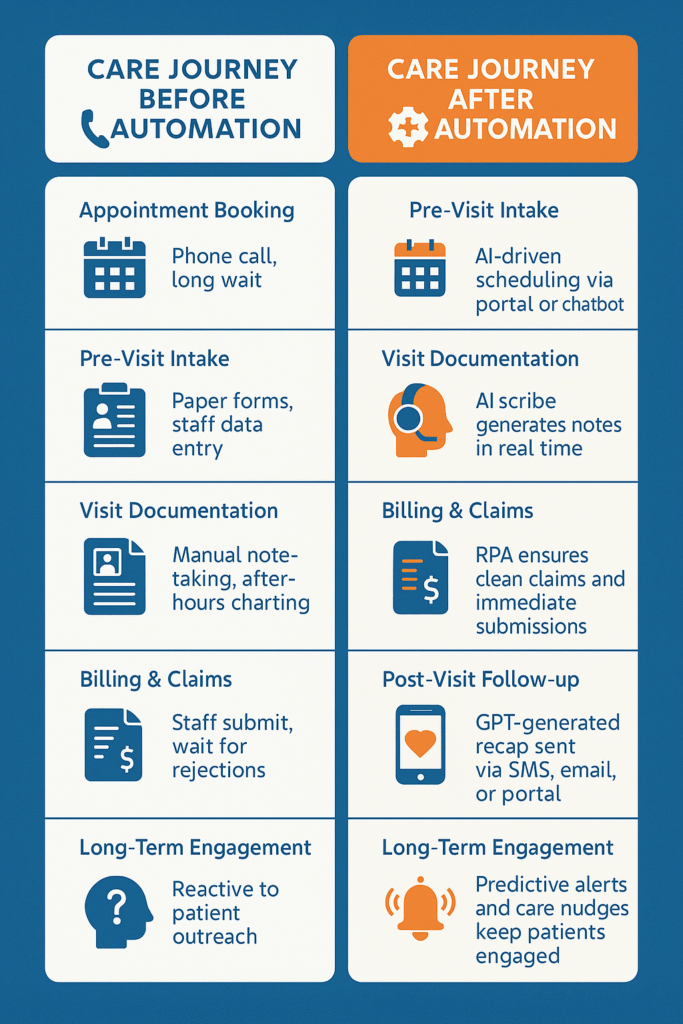Your cart is currently empty!
The COVID-19 pandemic thrust telehealth into the global spotlight, making virtual visits an overnight necessity. But in 2025, the healthcare landscape has evolved beyond webcam consultations and online scheduling.
Telehealth is no longer the end goal. It’s the launchpad. The future of care delivery is being shaped by intelligent automation—a new era of AI-powered systems that extend care beyond the clinic and empower healthcare providers to deliver faster, smarter, and more scalable solutions.
From virtual triage and ambient documentation to autonomous scheduling and predictive care alerts, intelligent automation is the next frontier for healthcare leaders ready to future-proof their delivery models.
From Virtual Visits to Virtual Infrastructure
Telehealth proved that patients are willing to receive care differently. Now, the challenge is delivering care intelligently, across an ecosystem where automation and AI aren’t just add-ons—they’re part of the infrastructure.
“Telehealth showed us what’s possible. Automation shows us what’s sustainable,” says Dr. Rani Mehta, Chief Innovation Officer at NovaCare Systems. “We’re moving from reactive medicine to proactive, predictive care—without adding more burden to the workforce.”
What Is Intelligent Automation in Healthcare?
Intelligent automation is the combination of artificial intelligence (AI), machine learning (ML), robotic process automation (RPA), and natural language processing (NLP) to perform tasks that typically require human intervention.
In healthcare, that means:
- Triage bots that assess symptoms and route patients appropriately
- AI scribes that transcribe, summarize, and code clinical notes
- Smart scheduling that reduces no-shows and optimizes provider utilization
- Predictive care engines that flag high-risk patients before complications arise
- Automated workflows for prior authorizations, billing, and referrals

Use Cases That Go Beyond Telehealth
1. AI-Powered Triage & Frontline Navigation
Before the visit even happens, automation can determine:
- Is this an emergency?
- Is telehealth appropriate?
- Does the patient need labs or referrals first?
Systems like Infermedica and Gyant are powering front-door automation that improves patient flow and reduces ER overload.
“We’ve seen triage AI reduce inappropriate ER visits by 12%,” reports Jamie Delgado, VP of Digital Care at CareFirst Collaborative.¹
2. Ambient Clinical Documentation
One of the most promising innovations: AI scribes that listen during patient visits and generate documentation automatically—freeing clinicians to focus on care.
Tools like Suki, DAX by Nuance, and custom GPTs can generate:
- Visit summaries
- Diagnostic codes
- Orders and prescriptions
- Follow-up reminders
“Our documentation time dropped 45%, and burnout decreased across the board,” says Dr. Leon Wu, Internal Medicine Lead at Saint Cloud Medical Group.
3. Predictive Risk Modeling
Machine learning algorithms trained on EHR data, social determinants of health, and lifestyle patterns can:
- Flag patients at risk for readmission
- Identify those who may benefit from remote monitoring
- Trigger automated outreach before an adverse event
These systems create a proactive care loop—turning episodic care into continuous engagement.
4. Virtual Back-Office Automation
Automation doesn’t stop at the bedside. It streamlines administrative operations such as:
- Prior authorizations
- Claims processing
- Referrals and care coordination
- Staff credentialing and scheduling
By reducing friction behind the scenes, organizations can cut costs and redeploy staff to higher-value work.
The Strategic Advantages of Intelligent Automation
✅ Scalability Without Burnout
Automation absorbs administrative load, allowing teams to scale services without overwhelming staff.
✅ Improved Patient Satisfaction
Faster access, shorter wait times, and seamless interactions improve NPS and loyalty.
✅ Reduced Costs
Fewer manual errors, shorter claim cycles, and optimized workflows lead to bottom-line savings.
✅ Stronger Compliance
Automated audit trails, documentation, and flagging reduce risk across billing and regulatory touchpoints.
“The organizations getting this right aren’t just adopting AI—they’re weaving it into their operating model,” says Malika Desai, Partner at HealthForward Strategy.
Future-Proofing Means Reimagining the Entire Care Journey
Intelligent automation isn’t just a tool—it’s a framework for healthcare transformation. Here’s what that journey looks like:
| Stage | Traditional Model | Automated Model |
|---|---|---|
| Appointment Booking | Phone call, long wait | AI-driven scheduling via portal or chatbot |
| Pre-Visit Intake | Paper forms, staff data entry | Automated intake forms and symptom checkers |
| Visit Documentation | Manual note-taking, after-hours charting | AI scribe generates notes in real time |
| Billing & Claims | Staff submit, wait for rejections | RPA ensures clean claims and immediate submissions |
| Post-Visit Follow-up | Patient forgets instructions | GPT-generated recap sent via SMS, email, or portal |
| Long-Term Engagement | Reactive to patient outreach | Predictive alerts and care nudges keep patients engaged |
Getting Started: How to Build an Automation-Ready Practice
- Start with High-Volume, Low-Risk Tasks
Automate appointment reminders, document retrieval, or FAQ responses. - Create Cross-Functional AI Teams
Involve IT, compliance, clinicians, and patient advocates in all implementations. - Choose Tools with Interoperability
Ensure automation platforms connect seamlessly with your EHR and CRM systems. - Pilot and Optimize
Begin with one department or workflow. Measure, iterate, and expand. - Educate & Align Your Team
Automation is a culture shift. Involve staff early and communicate clearly about goals.
Real-World Case Study: NovaPath Group’s Automated Workflow
NovaPath Group, a regional pathology services provider, deployed an automation suite that:
- Automatically assigned and routed cases
- Used AI to pre-fill portions of pathology reports
- Triggered billing and claims processing once cases were signed off
Result:
- Turnaround time reduced by 28%
- Manual errors decreased by 40%
- Revenue cycle shortened by 11 days
“It’s not about eliminating people—it’s about eliminating the repetitive friction so people can do their best work,” said COO Darnell Ho.
What’s Next? The Rise of the Autonomous Health Layer
Healthcare is heading toward ambient, invisible care—a world where the system anticipates patient needs and orchestrates solutions seamlessly.
- Virtual care becomes continuous
- Documentation becomes passive
- Billing becomes instantaneous
- Patient engagement becomes predictive
Organizations that embrace automation now will be positioned to lead, not react, as care delivery models continue to evolve.
Key Takeaways
- Telehealth was the beginning—intelligent automation is the evolution.
- Use cases include triage bots, AI documentation, smart scheduling, and risk modeling.
- Benefits span efficiency, scalability, compliance, and patient satisfaction.
- Strategic implementation requires cross-team alignment, interoperability, and trust.
- The future of care is automated, predictive, and patient-centered.
Bibliography
- CareFirst Collaborative. AI Triage Pilot Report 2025.
- Deloitte. Future of Healthcare Automation Survey. (2025)
- Saint Cloud Medical Group. Ambient Documentation Outcomes Review.
- Desai, M. (2025). The Automation Advantage in Healthcare. HealthForward Strategy
- NovaPath Group. Intelligent Workflow Efficiency Study. Q1 2025
#HealthcareAutomation #Telehealth2025 #IntelligentCare #AIinMedicine #DigitalHealth #HealthTech #FutureOfCare #AmbientDocumentation #PredictiveHealth #MedicalAI #ThoughtLeadership



Leave a Reply